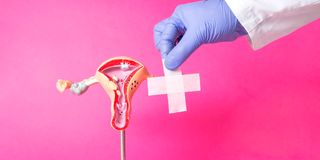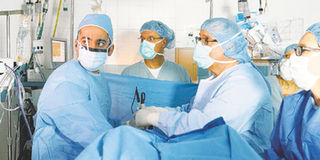Why young women are suffering from uterine fibroids

Fibroids can be symptomatic, non-symptomatic, painful or painless.
What you need to know:
- Historically, abnormal tissue growths in the uterus were typically associated with women in their forties and above.
- However, recent medical research and clinical data show a surge in fibroid diagnoses among women in their twenties and thirties
Since her high school days, Everlyne Mueni has been experiencing heavy menstrual bleeding with sharp pelvic pain.
At first, she dismissed the symptoms as part of the normal menstrual cycle, but they worsened.
She didn’t see many of her friends taken out by their periods the same way that she was, but no one really gave her the impression that her period experience was unusual. “I did my last paper in high school while in hospital because I started my menses on the last day of the exams,” Everlyne tells Healthy Nation. She was then aged 17. “The flow was very heavy and painful. I could not sit upright. That got me very worried.”
After school, the monthly pain characterised by intense cramping, heavy bleeding and clotting had become a deeply rooted part of her reality—one she had learned to live with. Regardless of her woes, Everlyne still looked forward to starting a family. Fast forward to 2019, she got married at the age of 24.
The problem persisted until she turned 27 last year. That’s when she decided to seek medical attention.
One busy morning, after three years of trying to get a baby unsuccessfully, she decided to visit her general physician who referred her to a specialist for checkup. “It is not that I was suspecting anything but I was just concerned about the pain, backache and heavy flow during my menses,” she says.
After consulting, Everlyne learned that she had multiple fibroids growing into the cavity of her uterus. This diagnosis came as a shock. She wondered whether the fibroids were affecting her chances of getting pregnant. But her doctor assured her that women with fibroids could still conceive. He recommended a comprehensive treatment plan.
Everlyne would then explore various treatment options. Weighing the pros and cons of every treatment, she went for a minimally invasive procedure, uterine artery embolization (UAE) to shrink her fibroids. But this did not work.
After six months, the fibroids were back again. She went for a myomectomy. During a myomectomy, a surgeon removes the fibroids but preserves the tissues in the uterus so that one can get pregnant in future.
The procedure went on smoothly and Everlyne gradually improved and finally recovered. After four months of trying to get a baby, she finally conceived. At the time of writing this story, she was six months pregnant.
“As I was going through treatment, it became clear that there is a possibility that fibroids can recur even during pregnancy,” says Everlyne, a hairdresser in Nairobi. She is being monitored closely by her doctor to ensure that the fibroids will not pose any complications in her pregnancy.
But hers is not an isolated case.

Common symptoms and complications of fibroids include heavy bleeding between or during periods, extended menstruation, menstrual clots and increased menstrual cramping.
Elizabeth* who requested to be identified by one name, is yet to have a baby 10 years into her marriage, thanks to fibroids that have been recurring ever since they were discovered. “It started as pain in the pelvis. This persisted until one day I sought help only to be told that my uterine was covered by fibroids,” says Elizabeth, 35.
She started her treatment journey at the age of 26, but this has been fraught with challenges. “None of the treatments has worked for me; with no baby to celebrate,” she says. But she is not giving up.
She calls for family support during such moments.
“If I had no support from my husband or family members, I would be drained by now. This is a journey that I would not wish any woman to go through. It is very traumatising,” she says
Everlyene and Elizabeth’s situations demonstrate the diverse experiences of young women who have been diagnosed with fibroids, shedding light on their challenges, triumphs and the importance of awareness and support.
Fibroids are a common health issue affecting millions of women worldwide. They are described as smooth muscle cells and connective tissue that are most often found in the uterus, but can also grow in other reproductive organs such as the fallopian tubes and ovaries.
They can be symptomatic, non-symptomatic, painful or painless. They materialise in different ways. While they can affect women of all ages, there is a rising trend in the diagnosis of fibroids among young women.
Historically, fibroids were typically associated with women in their forties and above. However, recent medical research and clinical data have shown a surge in fibroid diagnoses among women in their twenties and thirties.
The reasons behind this trend are multifaceted and still being explored by experts. Factors such as lifestyle changes, delayed childbearing, and increased awareness of fibroids have contributed to this shift, notes Dr John Ong’ech, a consultant obstetrician and gynaecologist.
Delaying childbirth
He tells Healthy Nation that many women are delaying childbirth and spacing a lot — these are known to be triggers of fibroids. “I am seeing many women in their thirties with fibroids. This is one of the most common surgeries that I do apart from caesarean section.”
In a day, Dr Ong’ech conducts four to five fibroid surgeries. This translates to over 150 surgeries in a month. He notes that many cases of young women who develop fibroids at an early age are due to inheritance and genetics. “If you happen to check the history of many young women who have developed fibroids, you find that either her mother had fibroids or she gave birth early. The trend is very clear and it is likely to affect family history,” he says.

When fibroids are diagnosed late, surgery may be necessary like in the photo .
He adds that women who begin menstruating early, for instance at the age of 11 years, are more likely to develop fibroids compared to women who begin menstruating after the age of 13.
“I also want to believe that people are now more aware and going for checkups, the condition could have been there before but with frequent checkups, more cases are being picked out unlike years back when the diagnosis was not readily available,” he says.
In the past, wellness checkups were rare but with the increase in diagnostic services, more cases are being picked out than ever before.
Some research findings indicate fibroids in young women develop when oestrogen levels are at their highest and shrink when these levels are low, such as after menopause when a woman’s monthly period stops.
“Fibroids need the hormone estrogen to grow. After menopause, estrogen levels decrease dramatically, which usually reduces the risk of developing fibroids. In many cases, fibroids shrink and cause fewer symptoms after menopause,” according to research published in the Women’s Health Clinical Research Center journal.
A 2022 study published in Nutrients, a peer-reviewed scientific journal of human nutrition, found a strong link between vitamin D deficiency and uterine fibroid formation. The findings also showed that a vitamin A-rich diet may prevent or limit the growth of fibroids as well.
Additional research has found that people who tend to eat at least four servings of fruit or vegetables a day are less likely to develop fibroids in comparison to those who only eat one serving in the same timeframe.
Putting this into perspective, Dr Ong’ech says estrogen should be maintained at a specific level, but if it runs too high or too low, it can cause complications.
“This hormone can impact the growth of uterine fibroids, benign tumours that develop within the uterus that may negatively affect fertility and cause painful symptoms,” he explains.
In most cases, he notes, if the body does not have sufficient progesterone, it can’t stop the growth. Progesterone not only limits the effects of estrogen on fibroids, but also deters their growth and shrinks the size.
To naturally balance the hormones since some of the drugs used have effects, experts advise that women should eat healthy, get enough sleep, reduce stress, maintain a moderate weight, exercise regularly and get enough protein in the body.
“At times it’s the little things that we keep ignoring like getting enough sleep that will balance our hormones. Watching weight more so for women of reproductive age is also important,” he advises.
Foods rich in high fat, processed meats and red processed meat are known to be high in added hormones, particularly estrogen. High-fat dairy products, conventional dairy can contain high levels of steroids, hormones and other chemicals that promote inflation.
Dr Ong'ech advises: “Healthy eating is also known to reduce the recurrence of the fibroids though I am now picking out the condition early in many women. This makes it easier to manage. I am also appealing to women not to wait for too long to have babies, say after 35 years. It is good to have at least the first baby when aged between 26 and 35 years. Doing it afterwards invites fibroids.” One with a family history of fibroids is at risk and it is good to be on the alert and go for an early checkup, he notes. “The earlier you pick it out the better because there are various interventions. The problem is that most people come late when fibroids are too many and big; with open surgery left as the only option to remove them,” Dr Ong'ech says.
He adds: “Have your first child as soon as it is feasible, avoid spacing for many years.” He advises that women with prolonged heavy bleeding (which can be heavy enough to cause anaemia) or painful periods, heavy or fullness in the pelvic area (lower stomach area), pain during sex and lower back pain should consider going for check-ups as they are potential candidates of the condition.
If left untreated, fibroid masses can continue to get larger, cause more intense symptoms and put physical pressure on other organs in the pelvic region. Thankfully, numerous forms of treatment can be tailored to a patient’s specific needs. There is also hormone therapy to shrink the size of the masses as well as introducing birth control pills including progesterone shots to help curb bleeding and pain.
Women can also choose other minimally invasive procedures such as uterine artery embolisation to cut off blood flow to the fibroids or undergo a hysteroscopic myomectomy or abdominal myomectomy to surgically remove the masses. A full hysterectomy, where the entire uterus is removed, is another option. “In most cases, I don’t remove the uterus, this is a precious part of the body of a woman,” Dr Ong'ech says, adding that with the severity and side effects of fibroids in some women, it’s important to work with your doctor to find the best treatment plan.
Everlyne is now an ambassador advocating for women to go for check-up whenever they feel something is not right with their bodies. “I am glad my situation was arrested early. It is my wish that no woman should not get a baby because of the growth of masses in the uterus. Early intervention is very necessary to arrest the situation early and when the masses are not big,” she says.





